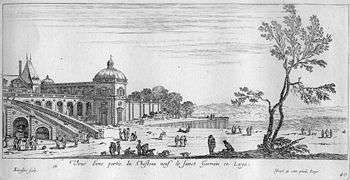Philibert de l'Orme

Philibert de l'Orme (pronounced: [filibɛːʁ dəlɔʁm]) (3–9 June 1514 – 8 January 1570) was a French architect and writer,[1] and one of the great masters of the French Renaissance.[2] His surname is also written De l'Orme, de L'Orme, or Delorme.
Biography
He was born in Lyon, the son of Jean de L'Orme, a master mason.[3] At an early age Philibert was sent to Italy to study (1533–1536) and was employed there by Pope Paul III. Returning to France he was patronized by Cardinal du Bellay at Lyon, and was sent by him about 1540 to Paris, where he began the Chateau de St Maur-des-Fossés, and enjoyed royal favour; in 1545 he was made architect to Francis I of France and given the charge of works in Brittany.

In 1548, Henry II gave him the supervision of Fontainebleau, Saint-Germain-en-Laye—where he built the Château Neuf (illustration, left) — and the other royal buildings; but on the King's death (1559) Philibert fell into disgrace. Under Charles IX, however, he returned to favour, and was employed to construct the Tuileries, in collaboration with Jean Bullant. He died in Paris.
Much of his work has disappeared, but his fame remains. An ardent humanist and student of the antique, he yet vindicated resolutely the French tradition in opposition to Italian tendencies; he was a man of independent mind and a vigorous originality. His masterpiece was the Château d'Anet (1552–1559), built for Diane de Poitiers, the plans of which are preserved in Jacques Androuet du Cerceau's Plus excellens bastimens de France, though part of the building alone remains; and his designs for the Tuileries (also given by Androuet du Cerceau), begun by Catherine de' Medici in 1565, were magnificent. His work is also seen at Chenonceau and other famous châteaux; and his tomb of Francis I at Saint Denis Basilica remains a perfect specimen of his art. He wrote two books on architecture: Nouvelles inventions pour bien bastir et à petits frais (1561) and Le premier tome de l'Architecture (1567).
See also
- Catherine de' Medici's building projects
- Basilica of the National Shrine of the Assumption of the Blessed Virgin Mary, influenced by Philibert Delorme
Notes
- ↑ Hoffmann 1996; Pérouse de Montclos 2000, p. 19.
- ↑ Blunt 1958, p. xiii.
- ↑ Hoffmann 1996; Potié 1996, p. 23 ("Il semble probable que cette stratégie d'ascension sociale ait été préparée de longue date par Jean de L'Orme qui savait que seule la hiérarchie ecclésiastique permettrait à un fils de maître-maçon d'espérer conquérir un statut plus enviable."). Jean is the modern spelling of Jehan.
Bibliography
- F. Lemerle & Y. Pauwels, Philibert De L'Orme (1514-1570). Un architecte dans l'histoire: Arts - Sciences - Techniques (= Études Renaissantes 17), Turnhout: Brepols Publishers, 2016, ISBN 978-2-503-56560-6
- Blunt, Anthony (1958). Philibert de l'Orme. London: A. Zwemmer. OCLC 554569. ISBN 9780302002629.
-
 This article incorporates text from a publication now in the public domain: Chisholm, Hugh, ed. (1911). "De L'Orme, Philibert". Encyclopædia Britannica (11th ed.). Cambridge University Press.
This article incorporates text from a publication now in the public domain: Chisholm, Hugh, ed. (1911). "De L'Orme, Philibert". Encyclopædia Britannica (11th ed.). Cambridge University Press. - Catholic Encyclopedia article
- (French) Philibert de l'Orme
- Hoffmann, Volker (1996). "L'Orme [Delorme], Philibert de" in The Dictionary of Art, 34 volumes, edited by Jane Turner. New York: Grove. ISBN 9781884446009. Also at Oxford Art Online (article updated 26 November 2003).
- Pérouse de Montclos, Jean-Marie (2000). Philibert De l'Orme : Architecte du roi (1514–1570). Paris: Mengès. ISBN 9782856204085.
- Potié, Philippe (1996). Philibert de L'Orme : Figures de la pensées constructive. Marseille: Parenthèses. ISBN 9782863640708.
External links
| Wikimedia Commons has media related to Philibert Delorme. |
- Nouvelles inventions pour bien bastir, 1561: copy at Gallica
- Le premier tome de l'architecture:
- 1567: copy at the website of the Library of the University of Bern
- 1567: illustrations at Gallica
- 1568: copy at the Internet Archive from the Research Library of the Getty Research Institute
- 1626: copy at the Internet Archive from the Research Library of the Getty Research Institute (includes de l'Orme's portrait engraving as well as Invention pour bien bastir)
- English translation of de l'Orme's Le premier tome de l'architecture
- French Renaissance architectural treatises, Centre d'Etudes Supérieures de la Renaissance
- Palladio's Literary Predecessors